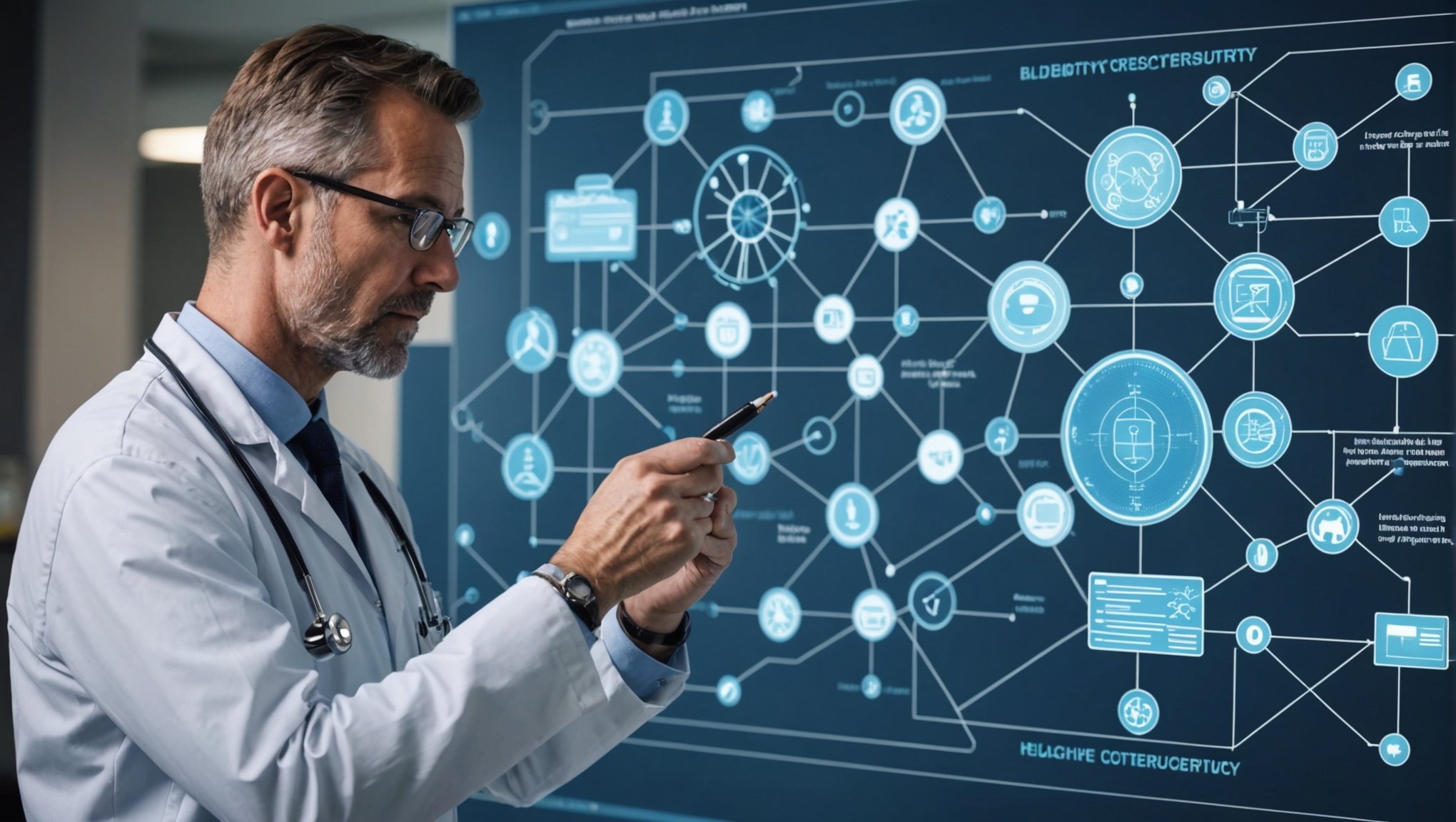Understanding the Cybersecurity Landscape in UK Healthcare
In the complex realm of UK healthcare, safeguarding sensitive patient information has become increasingly paramount. The cybersecurity landscape within this sector has seen significant evolution, driven by the integration of digital health technologies. With rising cyber threats, the importance of robust healthcare data protection cannot be overstated.
Cyber attacks on healthcare systems often lead to serious consequences, ranging from operational disruptions to the compromise of personal health data. Key statistics reveal that the UK healthcare sector faces an average of over 21,000 cyber attacks per week, underscoring the high frequency and potential impact of these threats. This makes cybersecurity a critical concern for healthcare administrators and policymakers.
Topic to read : Empowering Young Innovators: A Guide to Implementing Incubation Programs for Entrepreneurship in UK Schools
The significance of maintaining stringent cybersecurity measures lies in protecting patient trust and service integrity. When healthcare data is compromised, it can lead to identity theft, financial fraud, and even life-threatening situations if medical records are altered.
Despite the challenges, efforts to enhance healthcare data protection are ongoing. The establishment of regulatory frameworks and investment in cutting-edge security technologies are crucial strategies being deployed to combat these threats. By prioritising cybersecurity, the UK healthcare sector can safeguard its most valuable asset: patient information.
Have you seen this : Crafting a Robust Cybersecurity Blueprint for Financial Services in the UK: Essential Strategies and Best Practices
Key Regulations and Compliance Requirements
Understanding GDPR and its impact on healthcare is crucial for ensuring data protection. The General Data Protection Regulation mandates robust measures for handling personal data, aiming primarily to protect individuals’ privacy. For healthcare organizations, this means strict oversight on how patient information is collected, stored, and shared. Non-compliance can lead to hefty fines, making adherence an absolute necessity.
Additionally, NHS guidelines provide a framework to secure healthcare data from potential breaches. These cybersecurity guidelines outline standards that help protect sensitive information within healthcare systems, offering protocols on electronic data handling and storage. Following these guidelines not only prevents data breaches but also ensures a streamlined, secure environment for all stakeholders.
The combination of GDPR and NHS guidelines underscores the importance of compliance in building trust between healthcare providers and patients. Adhering to these regulations is not just about legal obligations; it’s about safeguarding patient data from misuse and protecting organisations from risks, ensuring that personal information remains confidential. Data protection regulations act as a foundation upon which ethical data handling practices are built, making it critical for healthcare organizations to integrate these into their operations. Maintaining compliance demonstrates a commitment to ethical standards and fortifies the trust that patients place in their healthcare providers.
Identifying Common Cyber Threats in Healthcare
In the realm of UK healthcare systems, cyber threats are emerging as formidable adversaries. One prevalent danger is the data breach, where unauthorised access is gained to sensitive patient information. This breach can result in identity theft or exploitation of personal data. Another threat is the infiltration of ransomware, where malicious software encrypts critical healthcare data, demanding a ransom for its release.
Healthcare vulnerabilities extend beyond computer systems. Many healthcare practices still rely on outdated technology, making them susceptible to cyber attacks. Moreover, the complex network of interconnected devices, from electronic health records to medical devices, expands the potential attack surface.
How do these threats manifest in real scenarios? Consider the ransomware attack on a major UK hospital in 2017. Critical systems were shut down, forcing a temporary closure of services and a shift to manual operations. This disruption not only endangered patient safety, but also resulted in significant financial loss for the organisation.
Effective threat assessment is vital. Healthcare entities must continuously evaluate their digital practices and infrastructure. By identifying vulnerabilities and implementing robust security measures, they can thwart potential cyber threats and protect sensitive patient data. This proactive approach underscores the importance of cybersecurity in safeguarding the future of healthcare.
Steps to Craft a Cybersecurity Blueprint
Crafting a cybersecurity strategy is essential for any organisation that values its data and operational integrity. In the process of blueprint development, several steps need attention to ensure comprehensive protection.
Initial Risk Assessment
Conducting a thorough risk assessment is the foundational step in developing an effective cybersecurity blueprint. This involves identifying potential threats and vulnerabilities specific to the organisation’s network and data. Key components to evaluate include the organisation’s IT infrastructure, data storage systems, and user access points. Utilising tools like vulnerability scanners and employing methodologies like the NIST Cybersecurity Framework can enhance the accuracy of the assessment.
Developing Security Policies and Protocols
Formulating robust security policies is crucial for ensuring data protection within healthcare organisations. Essential policies encompass data encryption, password management, and user access controls. To create these protocols, organisations should:
- Identify potential threats and vulnerabilities
- Establish clear, actionable guidelines
- Ensure comprehensive staff training
Staff training is vital, as it ensures the entire organisation adheres to these policies, effectively reducing the risk of breaches.
Implementing Technical Safeguards
The implementation of technical security measures underscores the protection of sensitive data. Technologies such as firewalls, antivirus software, and intrusion detection systems are pivotal in safeguarding digital assets. Regular updates and maintenance of IT infrastructure ensure these technologies operate effectively. Employing best practices, like secure network configurations and strong authentication processes, can further protect against threats.
Ongoing Monitoring and Incident Response
In the fast-evolving landscape of digital security, threat monitoring is crucial. Constant vigilance allows organisations to detect potential threats promptly, reducing the risk of data breaches. Continuous monitoring is vital as cyber threats continually evolve, necessitating a comprehensive approach to cybersecurity.
An effective incident response plan forms the backbone for managing security breaches. Such a plan should outline quick action protocols, designate clear roles and responsibilities, and ensure communication pathways remain open during an incident. Rapid identification and containment of threats rely heavily on this structured response, helping to minimize damage and downtime.
Regular cybersecurity audits and assessments reinforce the security framework. These audits serve to identify weaknesses, ensuring measures are up-to-date with technological advancements. They provide an opportunity to reassess the incident response plan’s effectiveness, making essential adjustments as the threat landscape shifts.
By integrating threat monitoring, a proactive incident response plan, and frequent audits, organisations can bolster their cybersecurity resilience. The ongoing assessment of these elements ensures that an organisation remains prepared against potential threats, maintaining the integrity and trust of its digital infrastructure. Adopting these strategies fosters an adaptive security posture, ready to tackle the dynamic nature of cyber world challenges.
Engaging Stakeholders and Building a Culture of Cybersecurity
To establish a robust cybersecurity culture, it is crucial to ensure active stakeholder engagement. Engaging leadership and staff in cybersecurity initiatives requires concerted effort and strategic planning. This means involving executives in decision-making processes and encouraging them to champion cybersecurity measures. Staff should be encouraged to participate in training sessions which not only enhance their understanding but also their vigilance against potential threats.
Strategies to Foster a Culture of Cybersecurity Awareness
Creating a culture of cybersecurity awareness demands a proactive approach. Employees should be consistently reminded of their role in protecting organisational assets. Regular employee training, featuring real-world scenarios, is essential. This may include workshops, interactive sessions, and the use of e-learning platforms tailored to various departments’ needs. Training should be dynamic and responsive to emerging threats and trends.
The Role of Ongoing Education and Training
Ongoing education plays an instrumental role in empowering employees to recognise and mitigate risks. Organisations can cultivate a resilient cybersecurity culture by integrating ongoing training into daily operations. Embedding cybersecurity into the organisational ethos ensures that all employees, from executives to entry-level staff, understand and appreciate their role in safeguarding information. Regular updates, refresher courses, and simulations can keep the workforce equipped and ready to tackle cybersecurity challenges.
Resources and Tools for Implementation
Navigating the intricate landscape of cybersecurity in healthcare requires targeted resources and effective tools. A well-thought-out cybersecurity strategy demands comprehensive resources ensuring robust defence mechanisms. One such approach involves leveraging implementation tools that are pivotal in safeguarding sensitive health data.
Cybersecurity Resources
A critical first step for any organization is to amass a wealth of resources related to cybersecurity. These resources offer guidance on developing security strategies, training employees, and maintaining compliance with healthcare regulations. Noteworthy mentions include cybersecurity frameworks like the NIST Cybersecurity Framework which details systematic approaches to identifying, assessing, and managing cybersecurity risks.
Recommended Implementation Tools
Healthcare organizations should utilize tools like advanced firewalls, Intrusion Detection Systems (IDS), and Security Information and Event Management (SIEM) solutions. These tools play an essential role in monitoring, detecting, and neutralizing potential threats. Incorporating these technologies ensures a resilient and responsive security posture.
Best Practices and Guidelines
Successful implementation is often driven by adhering to well-established best practices. Regular updates and patches, conducting periodic security audits, and continuous employee training programs are essential. These practices work hand-in-hand with technological tools, reinforcing a holistic approach to cybersecurity.
Incorporating these components equips healthcare providers to fortify their cybersecurity infrastructure effectively, safeguarding sensitive information against an ever-evolving array of threats.
















